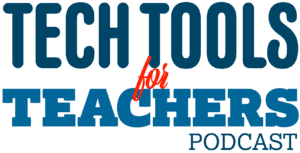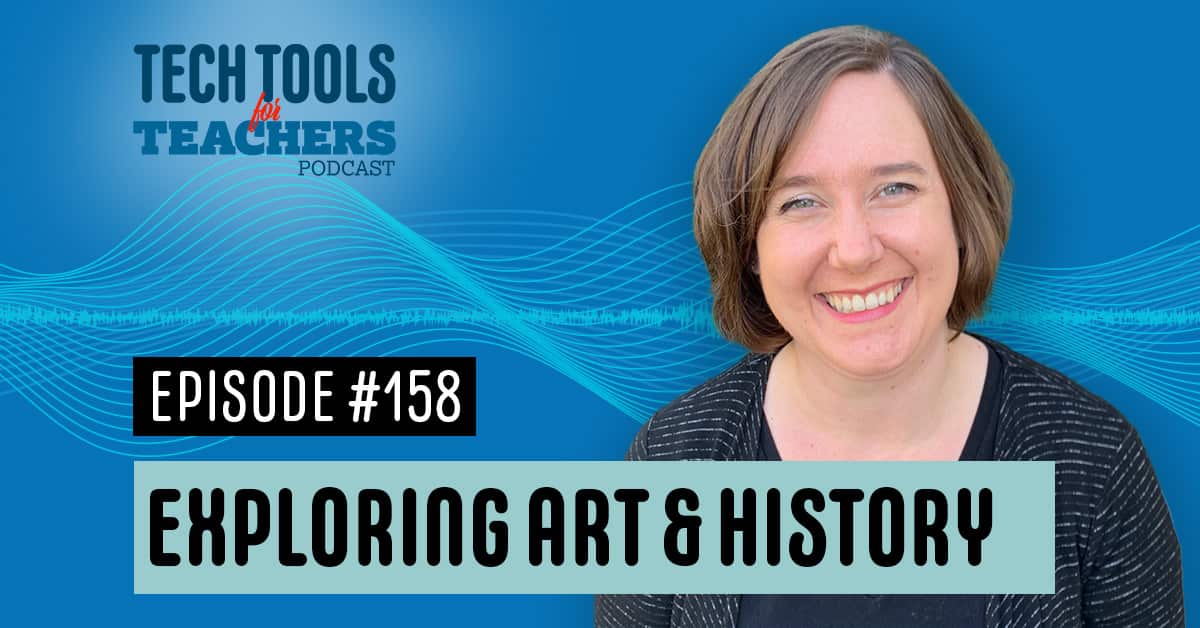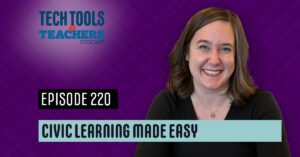Shanna Martin 0:19
Thanks for listening to the Tech Tools for Teachers Podcast, where each week we talk about a free piece of technology that you can use your classroom. I’m your host, Shanna Martin. I’m a middle school teacher Technology and Instructional Coach for my district.
Fuzz Martin 0:32
And I’m your producer and husband, Fuzz Martin, and I’m talking to you directly. I said it to the listeners today. For some reason, it was just by accident. Hey, do you know who my favorite Explorer was?
Shanna Martin 0:47
Magellan?
Fuzz Martin 0:48
Internet Explorer. But here I am.
Shanna Martin 0:54
Yay. Welcome to Episode 158. Yes, we are here.
Fuzz Martin 1:00
And we are family.
Shanna Martin 1:01
We are learning. And we are exploring. Exploring new school year. Oh, yeah. How’s it going so far? Good. It’s good. We are I am heading into week three. Again, some school districts we’re heading into week two. So far. Fantastic group of kids. And we’ve been learning already. And being productive human beings, which is always a great time.
Fuzz Martin 1:26
That’s That’s your job. Right? Is to Yeah, create productive humans.
Shanna Martin 1:31
Yeah, that’s right. Yeah. Good work. Yeah, it’s going good. Yeah, good. So far, so good. And I’m kind of excited. I mean, I am excited. I’m just kind of I am excited about this week’s chat. These are two websites that I found that both I have used a bit. And then also I’ve been sharing with other teachers who have been looking for some fun resources to start building in some more inquiry type things into their classrooms and giving students a way to like, hunt down information. And, and we’ve been talking about that a lot. So. So we’re gonna talk about that today. And because you’re such an explorer, we’re gonna start with our first our first site.
Fuzz Martin 2:09
I’m looking at the site in Chrome though, you’re not using internet, Internet Explorer, you know why? Because it’s 2023. And I also use a Mac, so
Shanna Martin 2:18
it just doesn’t work. So we’re gonna be talking about it’s called History Explorer, and it’s put together by the Smithsonian. So to find it, it’s historyexplorer.si.edu. And it’s a fantastic resource to get you started as a teacher with lesson planning, or to get students investigating different topics, or to look at primary source museum artifacts and things like that. There’s specific themes, there’s bookstore kind of resources. So it’s the Smithsonian’s, History Explorer, or just history Explorer. And it has all kinds of things. So if you’re walking through like the beginning part of the site, I have found that it looks like oh, it’s just information though. But really wait, there’s more. It’s one of those kinds of websites. So you can choose if you want to explore an artifact reviewed websites, materials, primary sources, interactive media, lesson plans, activities, or even worksheets, so you get to pick what you want. I’m gonna go for, let’s go for interactive media today, you can choose your grade level, which I always appreciate. So it’s gonna be leveled information in level text, K, 2, 3, 5, 6, 8, or 9-12. So we have the gamut, which is great. I’m going to choose 9-12 to begin with. And then what I really like is you can choose your historical era. So depending on what you’re teaching in class, or you want your students to focus on, you can pick from see the beginnings to 1620 all the way through the present. I’m going to randomly click on 1850, cross-curricular, and hit search. And this magic little button comes with all kinds of things for you. So there’s reference materials, I can choose like American democracy, a great leap of faith, there’s articles, there is a 3D tour of Abraham Lincoln’s life mask, which is kind of cool. And then you can choose your era. And then we’ll also link you to more articles, it will get you to the resource that you want. And what’s cool is that as you’re looking through different information, it will say like, if it’s going to link you to a museum artifact, or it’ll link you to a video, or it might be a different article, it also will take you to other websites as well, that will help you find information. So that’s pretty cool. So when you’re searching, you can also just like search lesson activities, and then choose your grade level. You will drop things specific to grade level. And one of the articles is young people shake up elections. It’s the one that keeps coming at the top and they’ve got 6-12 information, click Get the resource, it will give you the article and then it will it’ll have like LinkedIn, different information, lesson planning and things like that, that you can use. And it can you can use the information in your class. Students can use it if you just click on Like interactives and media, you can search a topic. So give me a topic search. What do I need? Oh, okay, typing in history, topics had
Fuzz Martin 5:18
The civil war. Okay, to be more specific, more specific are
Shanna Martin 5:24
The surrender at Appomattox.
Fuzz Martin 5:26
That’s what I was gonna say,
Shanna Martin 5:27
I know. So the surrender at Appomattox Courthouse, what are we gonna do today, it’ll give you related books. It will give me History Explorer sites, it will give me information. And I misspelled what I was typing. So it’s like, Hey, girl, you totally misspelled that. And now we’re fixing it. And today, era reading level, and I can find the things that I need. So it’s really cool. It also has options that you can choose bilingual if you want to, but it has an option if you’re looking for information as well, which is great and helpful, because we always appreciate such things. So yep, there’s great ways that you can search and find information that way. They also have museum artifacts. So you can go through the whole Smithsonian collection of awesomeness to search things that you are looking for, which is great themes you can go through and they will give you like a theme. And then they will pull like Constitution Day. And then they’ll pull all the articles and all the resources for you that way. book references will give you books if you’re looking for information. And if you click on the book, it’s pretty cool. You can find it a library near you. And it’ll give you book suggestions for the topics that you’re looking for. So, so many cool things with history explore, not just articles, but also I appreciate all of those museum pieces that pulls in as long as and as well as articles and things like that. There are lessons and there’s media, and there’s just all kinds of things. It’d be great for inquiry with students. And I appreciate the reference to k, k-12. So you can find the things that you need for your grade level and your topics that you are teaching or that you want kids to investigate or even just ask more questions about which is pretty cool. All of that is there, which is pretty awesome. I did talk about a different Smithsonian episode. This is only a learning lab, which was back in episode 89, which is another way of exploring through the Smithsonian, a little bit differently. So that is pretty cool, as well.
Fuzz Martin 7:29
Yeah, that’s cool. So that was on episode 89. We’ll put that in the show notes. So if you want to click over that easily, we’ll get you there. Or you can always use the search box on smart in wi.com. And that will pull up that function as well for episode 89 tee dee.
Shanna Martin 7:51
So that is specifiions. History explorer lessons and activities historyexplorer.si.edu Very good. Yeah. Yay. So another cool site that’s got a ton of resources for teachers. But this one is not just like research based or finding information, and those types of things. This site I stumbled across when I was looking for something else. And I’m like, wow, this is cool. You know, talk about it, look and say, so it’s hashtag met kid. Yes. Now I need to explain this a little bit. It is through the Metropolitan Museum of Art. And they point out it’s made for with and by kids, okay, the site is super cool. It’s one of those that you want to just drop in your Google Classroom, and kids can just be on it. And they’re going to be engaged in what they’re doing. With you go to the Met Museum of Art website, it’s like several clicks to get here versus if you just go to met museum.org/art/can. I
Fuzz Martin 8:59
give you a tip. Yeah, cuz nobody’s gonna remember that, like miniatures slash kids slash, if you type in Met Kids together one word, it’ll be the first result in Google. And you can get there very easily
Shanna Martin 9:11
correct. That would be your best way to get there is Met Kids in Google,
Fuzz Martin 9:14
otherwise, deep within the Met museum.org structure.
Shanna Martin 9:19
Basically, my thought is just get the link once and then bookmark it or throw it to Google Classroom so kids can get to it. Because once they do, there’s so many cool things that they can like, learn and explore on the side. So hashtag Met Kids has. It’s super cool. So your options are you can explore the map. So you click on the first button, and the kids can explore the map. That’s like welcomed the Metropolitan Museum of Art and then like talks about the Metropolitan, which I love because it gives kids like archaism, Wisconsin may have never traveled that way. And it gives like, Hey, this is like a cool Museum and another part of the country. And then maybe you can learn more about the East Coast. What’s New colored anyway? I just think about all those things. So the first exploration piece of the Met, you can zoom in, zoom out. And there’s it’s almost like Where’s Waldo is like all of the it’s just like an image with all these little cartoon people. And these are red and yellow dots everywhere. So if you click on the red dots and the yellow dots, they take you around the museum. They zoom in, they give you information about it. They let you imagine. Oh, yeah. And there’s like fun stuff. And then so basically, there’s like, here’s a fact tides clicked on the golden goblet, with personifications of Cyprus, Rome, Constantinople, and Alexandria. Cool. There’s a fun fact. So this goblet is heavy to lift and when it is not filled with something to drink made of solid gold. Okay, cool. So it gives you like the background of the object and the Discover part, then they have an imagined part. So some people think the treasure belong to a VAR chief, am saying that right? Others say it was an artist who worked with golden silver, what would you do with this fancy golden cup? What would you like to drink out of it? It’s like poses questions to like, bring it into their world? Like, why would I care about the scope, and then they have a Create Section. So this treasure wasn’t discovered for hundreds of years afterwards, buried, someone should have a treasure map, make your own treasure chest and treasure map. So it gives kids like the information, something to think about and then create a connection and like make like seems like a little project basically, or an assignment or whatever to go with it, which is really cool. So each of the red buttons will have like that discover, imagine create part, which is really cool. And they’re different artifacts around the museum. Then if you click on the yellow part, like the yellow little find, well, Where’s Waldo dots, those are just specific to the museum. So like, here’s the gift shop, here’s the information desk. Here’s the great hall of flowers. So it’s cool as then you get like a little tour through the museum. And then all of the red buttons give you all of these cool, fun, interactive facts. And you can answer questions. And you can build that into like little writing projects or little projects throughout your classroom and just let kids do a whole inquiry based on their adventure of the Met Museum. Which is all just in the map section. Which is very cool. Though, then, if you click on Time Machine, which is probably my favorite.
Fuzz Martin 12:29
Yeah, that was word that noise that you heard earlier, earlier came from
Shanna Martin 12:33
Yes. So when you’re in the time machine, because clearly are skipping ahead of me. What you do is you have to choose a time period, geography, so a place in the world, and then a big idea. So I’m gonna choose like 1600 to 1800 AD. And then I’m a geography I’m going to pick Europe. And then big ideas I can choose from inventions, creatures, mythologies, sports, games, secrets, city and country magic and mystery fashion are spaces and places I’m choosing secret. Then when you pick these ideas, it gets a little light, twirly totally thing and you push the red button, and then boom, you get cool things in the museum. So you can then it’ll load it in to like where it is in the museum. It’ll give you a fun fact, mine came up with a painting the fortune teller. And then Fun fact, discover, imagine and create all comes up. So it’s a way of like exploring the museum specific to a time period and a place in the world. So you could totally set kids up for like a cool exploration, if you’re studying a specific part of the world. Or if you want them to engage in different time periods in the world is really fun to like, click around and have this information come up at you, which is pretty neat.
Fuzz Martin 13:58
That’s super cool. And also with the time machine, you don’t have to select like an order, you don’t have to pick the location. Like you can just select like I’m on. Like sports right now. Yeah. And it’ll bring up those without you having to go,
Shanna Martin 14:15
you don’t have to go through all the pieces. You don’t have to narrow it down as much. And then you click the button to hop back in that time machine and they can pick something else, which is really cool. It’s cool. And then where’d you go? Would you see? Tell us about the world I don’t know. It’s cool. And they could share it out in front of their classmates or share it with a partner and then do some more additional research. Very excited about this. And then the third category is videos. And what’s cool about these videos is the q&a is that have been collected so like how can art tell us about who we are and can painting tell more than one story so it gives connections to art specifically with q&a videos, that would be great for class discussion and for having a students learn a little bit more about different parts of the world and different things like so that kids has then these cool videos that Lincoln as well, which is pretty awesome. And then you just go back to the menu button. And if you choose to you can visit the museum, and then it takes you like to different parts of the museum. So it’s wonderful. Yeah. So Met Kids has like all these resources. And it would be very easy to give students I would say, probably guided as a class first, second and third grade. But I would say like for sixth grade on up could easily navigate this on their own and kind of pull in their own inquiry and different things like that. And it would be really fun and easy to spark conversations with students. Great. There you go.
Fuzz Martin 15:39
Met Kids again, search MetKids on Google, and you’ll get there faster. By the words together, MetKids together. It’ll pop up. Yes.
Shanna Martin 15:48
My last little tidbit of information, because today is September 11. Yes. And last year, I had done a whole collection of resources for September 11. So I know I’m teaching this September 11. Today and tomorrow, because to me, it’s at least two days and we carry on the discussion. But in Episode 125, I referenced several resources for 911. Should you need them for discussion in your classroom, either in the state of Wisconsin or like the National Museum in New York. So yeah, there’s lots of resources out there. But if you need a quick reference, Episode 125 offers resources for you for today. Perfect. So there you go. Yeah, yeah. So episode 158. historical things and some cool exploration things and they get kids digging into some inquiry learning, which I always love. Indeed. There you go. Look at us rocking out the first weeks of school. Oh, yeah. All right. Good work.
Shanna Martin 16:43
So thanks for tuning in. This has been the Tech Tools for Teachers Podcast. If you ever have questions, you can find me on the app formerly known as Twitter, smartinwi.com Oops, smartinwi or on Threads where I am just me smartinwi. And if you want to get more information on the links to the technology discussed in this episode, you can visit smartinwi.com Or you can find me on Facebook too, because that hasn’t changed. If you’d like to support the show, please consider buying me a coffee or to visit buy me a coffee.com/smartinwi or visit smartinwi.com and click on that cute little purple coffee cup. Your donations help keep the show going. New episodes each week. Thanks for listening, go educate and innovate.
Fuzz Martin 17:26
The ideas and opinions expressed on this podcast and the smartinwi.com website are those of the author Shanna Martin and not of her employer. Prior to using any of the technologies that we’ve discussed on this podcast, please consult with your employer regulations. This podcast offers no guarantee that these tools will work for you as described, but we sure hope they do. And we’ll talk to you next time right here on the Tech Tools for Teachers Podcast.












